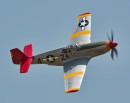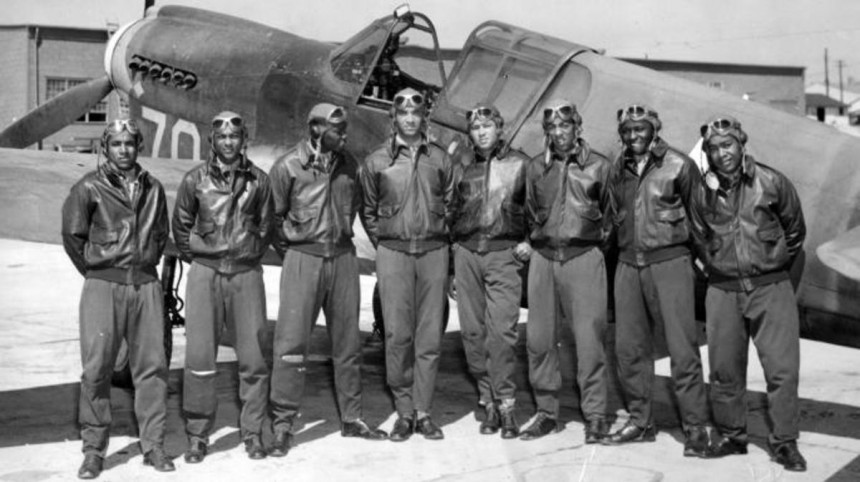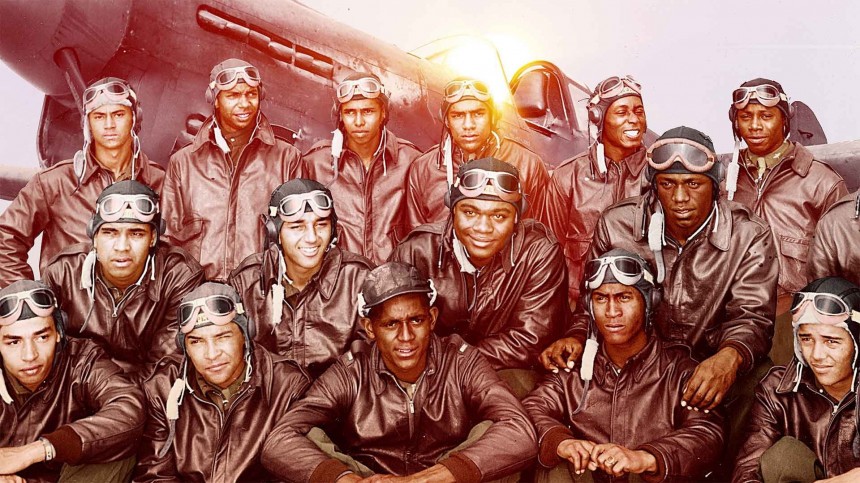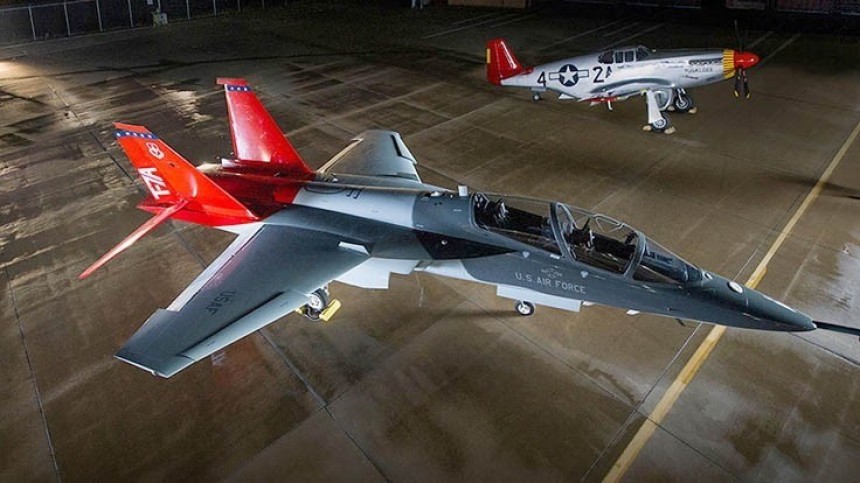Give or take a couple of days, 81 years ago, a group of African American pilots formed an Army Air Corps squadron that destroyed quite a bit more than the German Luftwaffe's morale.
A group that shattered color barriers and showcased to the American people how ferociously they could fight when its citizens put their preconceived biases aside. Many amongst their ranks have since sadly departed from this Earthly plane. But rest assured, the story of the Tuskegee Airmen will outlive the pilots themselves and any of us landlocked civilians who admire them.
In their honor, let's take a deep dive into a squadron of African American pilots who absolutely bodied the German Luftwaffe. But also the Jim Crow laws that so often ill-treated them. That's how amazing at their jobs they were.
Remember, the U.S. entered the Second World War less than a century after a bloody Civil War. A conflict that killed over half a million American soldiers. The self-determination of the enslaved African American population was a cornerstone of this war, as we all know.
But by the time of the early 1940s, the after-effects of 1865 were still felt all over the union. Blatantly discriminatory Jim Crow laws designed to subjugate the descendants of freed slaves wouldn't stop an extraordinary group of men from contributing an absolutely breathtaking story to World War II. A conflict so often devoid of conventional humanity.
Before 1941, no African American man or woman had ever been selected for service in the United States Army Air Corps, the forbearer to the modern U.S. Air Force. An African American man, Eugene Jacques Bullard, did serve with the French Army Air Service for a brief period in the summer of 1917. But as for piloting genuine American warbirds, such a thing was unheard of.
As absurd and ham-fisted as we may perceive it today, the prevailing theory of the time was that African American soldiers were somehow inferior to the Caucasians, unable to handle the complexity of contemporary weaponry. Thus, most POC American draftees and soldiers were often relegated to mundane logistical deployments instead of active combat roles.
Such an objectively false notion was even believed by Henry "Hap" Arnold, the famous Chief of the Army Air Corps at the time of the Tuskeegee Airmen's genesis. It wasn't until 1939 that President Franklin Roosevelt ordered the American Civilian Pilot Training Program to accept African American trainees into their ranks mandatorily.
It's been said that pressure from the media and his own wife Eleanor swayed the four-term president's decision. Soon after, the program was expanded to the military side of things. The first racially integrated flight school opened in December 1940 in Tuskegee, Alabama.
By April 1943, the first full squadron of African American fighter pilots, the 99th Fighter Squadron, received their first deployment orders to participate in combat in the European Theater of the Second World War, particularly in the Mediterranian.
Over the skies of Italy and Romania, the 99th Fighter Squadron escorted hoards of 15th Air Force B-25 Mitchell bombers. All while piloting their iconic North American P-51 Mustangs and Republic P-47 Thunderbolts.
Their valiant early service foreshadowed the mythical status the group was soon to obtain. By the time of D-Day in June 1944, as many as four different all-black fighter squadrons were operational, including the 99th.
These squadrons would consolidate into what was known at that time as the 332nd Fighter Group. The first group of fighter pilots to be colloquially called the Tuskegee Airmen. It's an informal designation that's resonated far greater than just the 332nd.
The aircraft of the 332nd were distinguishable by their painted red tails, a trait that's seen with their P-47s and P-51s, but also lesser flown aircraft in their ranks like the Curtis P-40 Warhawk and Bell P-39 Aerocobra.
Just under a thousand men were trained at Tuskegee between 1941 and 1946. Just over 350 were deployed overseas, of which 84 were killed. 68 were believed to be killed in combat. All while shooting down a total of 112 enemy aircraft. Including Bf-109's Fw-190s, Romanian IAR-80s, and even a couple of Messerschmitt Me-262 jet fighters. Even so, the Tuskegee Airmen returned victoriously to the U.S. to find Jim Crow laws as strong as ever.
It would be a further 20 years before the Civil Rights movement of the 1960s ended the practice of Jim Crow forever. Tuskegee Airmen alumn were among those marching with Martin Luthor King Jr on the streets of Washington D.C. during his famous "I Have a Dream" speech.
Today, the memories of all who served in the 332nd fighter group have their legacy enshrined forever in museums across the country. But also in the naming of the modern Air Force's newest jet trainer, dubbed the Boeing-Saab T-7 Red Hawk, in honor of iconic Red Tails of the Second World War.
Check out this link to the Tuskegee Airmen's official bio page for the National Museum of the United States Air Force if you want to learn more about the individual men who trained at Tuskegee. The number of stories that the group could tell could fill several novels.
In their honor, let's take a deep dive into a squadron of African American pilots who absolutely bodied the German Luftwaffe. But also the Jim Crow laws that so often ill-treated them. That's how amazing at their jobs they were.
Remember, the U.S. entered the Second World War less than a century after a bloody Civil War. A conflict that killed over half a million American soldiers. The self-determination of the enslaved African American population was a cornerstone of this war, as we all know.
But by the time of the early 1940s, the after-effects of 1865 were still felt all over the union. Blatantly discriminatory Jim Crow laws designed to subjugate the descendants of freed slaves wouldn't stop an extraordinary group of men from contributing an absolutely breathtaking story to World War II. A conflict so often devoid of conventional humanity.
As absurd and ham-fisted as we may perceive it today, the prevailing theory of the time was that African American soldiers were somehow inferior to the Caucasians, unable to handle the complexity of contemporary weaponry. Thus, most POC American draftees and soldiers were often relegated to mundane logistical deployments instead of active combat roles.
Such an objectively false notion was even believed by Henry "Hap" Arnold, the famous Chief of the Army Air Corps at the time of the Tuskeegee Airmen's genesis. It wasn't until 1939 that President Franklin Roosevelt ordered the American Civilian Pilot Training Program to accept African American trainees into their ranks mandatorily.
It's been said that pressure from the media and his own wife Eleanor swayed the four-term president's decision. Soon after, the program was expanded to the military side of things. The first racially integrated flight school opened in December 1940 in Tuskegee, Alabama.
Over the skies of Italy and Romania, the 99th Fighter Squadron escorted hoards of 15th Air Force B-25 Mitchell bombers. All while piloting their iconic North American P-51 Mustangs and Republic P-47 Thunderbolts.
Their valiant early service foreshadowed the mythical status the group was soon to obtain. By the time of D-Day in June 1944, as many as four different all-black fighter squadrons were operational, including the 99th.
These squadrons would consolidate into what was known at that time as the 332nd Fighter Group. The first group of fighter pilots to be colloquially called the Tuskegee Airmen. It's an informal designation that's resonated far greater than just the 332nd.
Just under a thousand men were trained at Tuskegee between 1941 and 1946. Just over 350 were deployed overseas, of which 84 were killed. 68 were believed to be killed in combat. All while shooting down a total of 112 enemy aircraft. Including Bf-109's Fw-190s, Romanian IAR-80s, and even a couple of Messerschmitt Me-262 jet fighters. Even so, the Tuskegee Airmen returned victoriously to the U.S. to find Jim Crow laws as strong as ever.
It would be a further 20 years before the Civil Rights movement of the 1960s ended the practice of Jim Crow forever. Tuskegee Airmen alumn were among those marching with Martin Luthor King Jr on the streets of Washington D.C. during his famous "I Have a Dream" speech.
Today, the memories of all who served in the 332nd fighter group have their legacy enshrined forever in museums across the country. But also in the naming of the modern Air Force's newest jet trainer, dubbed the Boeing-Saab T-7 Red Hawk, in honor of iconic Red Tails of the Second World War.












